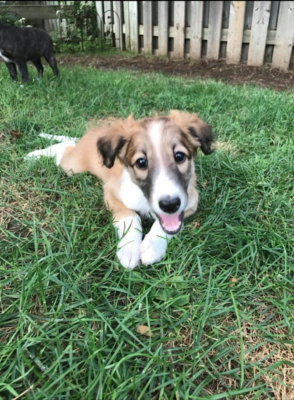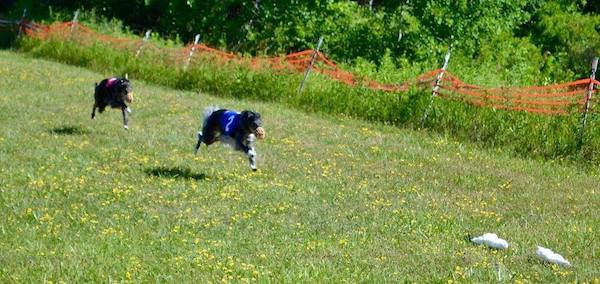
Standing at about 13 to 15 inches is the Italian Greyhound, the smallest of the sighthounds, while a male Irish Wolfhound can range from 32 to 34 inches making it the tallest of the sighthounds. Back in the 70s, Borzoi breeder, Francie Stull, thought there needed to be a sighthound that filled the size in between, a breed that still maintained a wonderful temperament, and the sporting abilities of the other sighthounds.
Stull was determined to create a mid-sized sighthound. She crossed some of her top performance Borzois with Walter Wheeler’s lurchers (he referred to them as Long Haired Whippets, but DNA has since proved the existence of Sheltie or Border Collie in those lurchers). Later, Stull added a Whippet from Peru named, “Bengala” who was bred to some of the early F1 and F2 Silkens.

Photo by Kemp Photography and shared by Joyce Chin
The first litter of Silken Windhounds – the “D” litter – was born in 1985 on a ranch in Austin, Texas, but the breed wasn’t officially named “Silken Windhound” until 1998. A year later, the International Silken Windhound Society was formed, its charter to maintain pedigrees and DNA-verified registrations for the breed. It didn’t take long for the Silken Windhound to spread throughout the Unites States and other countries, and in 2000, the studbook was officially closed.
Not surprisingly, the Silken Windhound is an excellent courser, and seems to be more biddable than many sighthounds.

Photo by Lisa Adams Finlay
It also appears to be a long-lived breed as it’s quite common to see Silkens in their mid teens and occasionally, even older.
The breed is not yet recognized by the AKC or FCI, but the United Kennel Club accepted the Silken Windhound in 2011. There exists a Finnish Silken Windhound club, as well as a club in Sweden. The Hungarian Kennel Club (an FCI member) allows Silken Windhounds to compete in their confirmation shows and to earn Hungarian champion titles, as well as by the Slovenian Kennel Club. Silkens have also been recognized by all of the sighthound racing and coursing associations – ASFA, NOTRA, LRGA, and NOFCA.
You can read more about the breed (and see photographs) here.
Thumbnail photo by Lisa Adams Finlay

The Basenji serves the same purpose
If the purpose was a medium sized, longhaired Sighthound, then the Basenji does not qualify and does not serve the same purpose.
Having both basenjis and silkens, they are very different. Very different
true, and not American.
Also, for me, another purpose is “I really don’t want to live with a Basenji”.